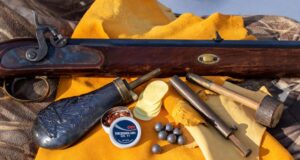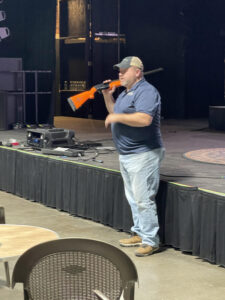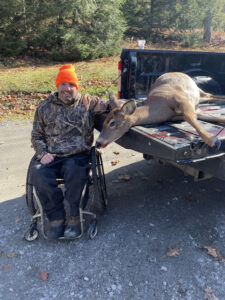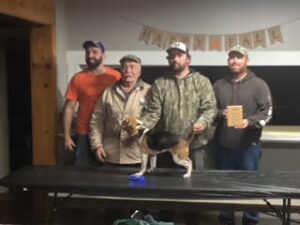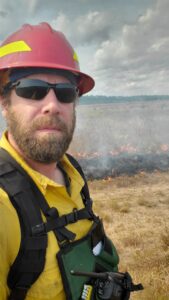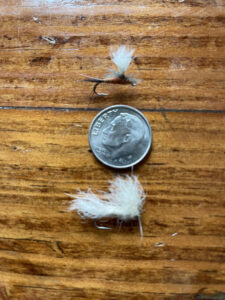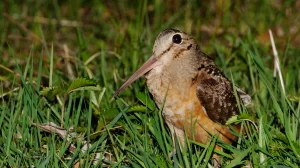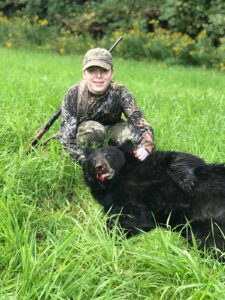The shotgun deer hunting and late bear hunting seasons end this weekend, but the Primitive Firearm deer hunting season opens on Monday, December 11 and ends on Saturday, December 30. During the Primitive Deer Hunting season, hunters must use a muzzleloader firearm or archery equipment, and must comply with abstracts listed in the 2023 MA Hunting, Fishing and Trapping Regulations.
Hunters must use shoulder-fired muzzleloaders .44 caliber to .775 caliber; barrel length 18 inches or more with only one barrel operational. Inline ignition systems are permitted provided the firearm loads from the muzzle. Single projectile only (no buckshot). Sabot rounds, 209 primers, break/hinge-action muzzleloaders, and scopes are permitted. Powder is limited to black powder or black powder substitutes.
A muzzleloader is considered unloaded when the cap or pan powder is removed.
All primitive firearms deer hunters must comply with the 500 square inch blaze orange requirement. A primitive firearm stamp is required.
Hunters may also archery hunt during the primitive firearm season. There are certain regulations which govern archery hunting, so be sure to review them in the above-mentioned regulations. A primitive firearm stamp is required for archers, too.
Hunters can report their deer harvest online rather than an official check-in station. It must be reported within 48 hours of harvest.
For some of us, muzzleloader (black powder) deer hunting is even more enjoyable than shotgun hunting. There is something about it. Perhaps it’s a link to the hunters of bygone years. Perhaps it’s the challenge of having only one shot to get the deer. About the only drawback, other than the cold and keeping the gun powder dry, is the fact that bucks sometimes drop their antlers in late December. Unless one possesses an antlerless deer permit, it is illegal to shoot them. An antlered buck, as allowed by the Hunting abstracts, is that at least one antler must be 3 or more inches long.
Sometimes a doe will have antlers causing difficulty in distinguishing it at a distance. Therefore, it is legal to harvest a doe with antlers but it must be tagged with an antlered deer tag.
Here’s hoping the hunters have a safe, enjoyable primitive firearms hunting season and remember, keep your powder dry.
Some small game hunting resumes on December 11, such as pheasant hunting, which now runs until December 30. Also, cottontail rabbit, snowshoe hare and gray squirrel hunting seasons resume on the 11th and run until February 29, 2024. For the hardy waterfowlers, the regular Canada goose hunting season resumes on December 11 and runs until December 14. The duck hunting season in the Berkshires resumes on December 11 and runs until December 30. Be sure to check the 2023-2024 Migratory Game Bird Regulations.
Dangerous dam to be removed
The Healey-Driscoll Administration recently announced an investment of $25 million to remove eight aging dams in Central and Western Massachusetts, including the abandoned high-hazard Bel Air Dam in Pittsfield. Removing these hazardous and aging dams will restore fish and other wildlife habitat, increase biodiversity, improve water quality, promote climate resiliency, and make communities safer.
“This summer, we saw firsthand the catastrophic impacts of severe flooding and the stress and pressure it puts on our dams. Our administration recognizes the severe threats these dams pose to our cities and towns, and we are taking swift action to remove these obsolete structures,” said Governor Maura Healey. “This is a lifesaving investment that will protect our residents’ and communities’ safety and security.”
The projects are funded through the American Rescue Plan Act (ARPA). Of the $25 million, $20 million will support the removal of Bel Air Dam, and $5 million will go toward the removal of seven dams located in areas managed by the DFW (MassWildlife), one of them being the Weston Brook Dam in Windsor. Weston Brook, which is located in the Chalet Wildlife Management Area, doesn’t impound much water but is a fish passage barrier on a cold water stream. The project is more about habitat restoration than safety.
This year’s damaging storms emphasized that we have to move with urgency,” said Energy and Environmental Affairs Secretary Rebecca Tepper. “As we continue to experience more frequent severe weather events, it is vital that we address the infrastructure that is most impacted. We are putting this money to work to make our communities more resilient to climate change.”
“With the extreme rainfall this year, we have seen firsthand how important a well-functioning dam system is for the safety of our communities and preservation of our natural resources,” said DCR Commissioner Brian Arrigo. “This funding to remove the hazardous dam will ensure that we can protect the downstream community, restore the natural environment, and enable us to rededicate our resources to ensuring other dam infrastructure is in good condition.”
“The Department of Fish & Game has a special responsibility to be stewards of our rivers and streams for the fish and wildlife that depend on them,” said DFG Commissioner Tom O’Shea. “Dam removal is greatly beneficial to wildlife and one of the keys to improving native biodiversity.”
“During my administration, we have developed great partners at all levels of government. The Bel Air Dam removal project is another example of what we have been able to accomplish when we are all working towards the same goal. I am grateful for the continued support of the Healey-Driscoll administration as we make improvements to environmental quality throughout Pittsfield,” said Mayor Linda M. Tyer.
The removal of the Bel Air Dam will reduce the risk of downstream flooding related to the dam’s failure. The potential flooding would affect nearly 500 parcels of land, including residential, business, commercial, and industrial areas located within the low-income community downstream, as well as impact five bridges in the inundation area. A dam failure could potentially cause loss of life and substantial damage to buildings, roadways, and other infrastructure in the city. It could also put the health of the community at risk by exposing them to sediment contaminants, including lead and chromium.
As part of dam removal and site restoration, DCR will manage contaminated sediment accumulated at Bel Air Dam and dispose of them off-site to reduce the risk of adverse public health effects in the surrounding community.
Junior Duck Stamp contest
There is still time to enter the Massachusetts Junior Duck Stamp (JDS) contest. Students from kindergarten through grade 12 can submit original artwork to participate in this fun and educational competition. The entry deadline is February 15, 2024. The process of creating these works of art allows students to appreciate the importance of preserving wetland habitats and the delights and diversity of wildlife. “Even if students do not enter the competition, science and art teachers will value the JDS curriculum as a useful resource,” advises MassWildlife’s Education Coordinator, Pam Landry.
The JDS program links the study of wetlands and waterfowl conservation with the creation of original artwork. Students in grades K-12 learn about the habitat requirements of various kinds of ducks and geese and then express their knowledge of the beauty, diversity, and interdependence of these species artistically, by creating a drawing or painting which can be submitted to the JDS art contest. The art is judged in four age group categories in a statewide competition; the entry judged Best of Show moves on to represent Massachusetts in the national JDS competition.
For more information contact Pam Landry at pam.landry@mass.gov.
2024 Massachusetts Freshwater Fishing, Hunting and Trapping Laws are now available
Commonly called “the abstracts” they are available in the usual places. The booklet has a cover picture of a big black bear.
New regulations for 2024 are as follows:
- The archery deer and fall wild turkey seasons now open two weeks earlier in Wildlife Management Zones 1-9.
- MA Share the Harvest- With the support of donors, hunters who donate their entire deer pay no processing or packaging fees. Hunters who donate a portion of their deer will pay a discounted processing rate, depending on the amount donated.
- MA is now part of the Interstate Wildlife Violators Compact. If any individual’s recreational licenses are suspended in any other US state due to the violation of reciprocal hunting, fishing or trapping laws, their privileges in MA are also suspended and vice versa.
- A Youth Catch-and-Release category has been added to the Freshwater Sportfishing Award’s Program. Also, two new species – fallfish and white sucker – have been added.

